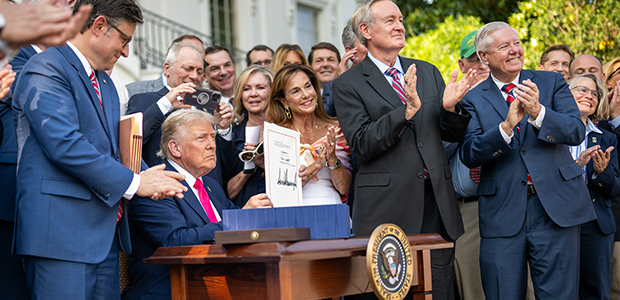
One Big Beautiful Bill Act Includes Many Pro-Oil Provisions
The final version of the One Big Beautiful Bill Act, which President Trump signed into law over the Independence Day weekend, contains several changes to energy policy that will encourage oil and gas development.
According to the Institute for Energy Research, these changes include allowing producers “to fully deduct intangible drilling costs, which encompass roughly 60%-80% of well costs.” The Institute points out that the Inflation Reduction Act only allowed a portion of those intangible drilling costs to be deducted.
The act also “delays the methane emissions fee until 2035—providing the industry with more time to prepare—and increases the carbon capture tax credit for producers that utilize carbon dioxide to increase oil recovery,” the Institute says.
Specifically, the law amends the 45Q tax credit for carbon sequestration to bring enhanced oil recovery to parity with other carbon sequestration techniques. “As a result of the OBBBA, the $85 per metric ton credit ($180 for direct air capture), previously only available for carbon oxides permanently sequestered and not used in enhanced oil or natural gas recovery projects, will also apply to projects placed in service after July 4, 2025, that (i) use the permanently sequestered carbon oxides in EOR projects or (ii) utilize carbon oxides in other permitted forms,” describes law firm James Walker.
“Prior to the OBBBA, the maximum tax credit available for carbon oxides that were permanently sequestered through EOR projects or other utilization methods was $60 per ton,” the firm says. “All permitted forms of carbon oxide sequestration under the credit may now see the maximum available credit.”
Leasing
The changes to leasing in the act represent a major policy shift from the previous administration, IER notes. “President Biden’s signature climate bill, the Democrat-passed IRA, linked offshore oil and gas lease sales to those of offshore wind, and Biden’s five-year offshore lease plan for oil and gas called for only three offshore lease sales—the fewest offshore oil and gas leases in the industry’s history and far fewer than the 47 sales proposed by President Trump in his first term,” IER recalls.
“Trump’s bill requires the federal government to augment that historically low number of sales under Biden’s 2024-29 leasing program for the U.S. Gulf of America (Mexico) with 30 additional offerings across the Gulf region over 15 years,” the Institute contrasts. “One lease sale is required to take place by the end of the year, and Interior Secretary Doug Burgum has it planned for December 10, 2025.”
The law says that at least six lease sales must take place in Alaska’s Cook Inlet by 2032, with at least one taking place next year and every following year except 2029.
Turning onshore, the OBBBA requires the Department of Interior to conduct at least four lease sales every year in each of the following nine states: Alaska, Colorado, Oklahoma, Montana, Nevada, New Mexico, North Dakota, Utah and Wyoming. IER adds that the act “reinstates royalty rates to their pre-IRA rate of 12.5%-16.7% and allows noncompetitive bids, which the IRA had ended.”
Renewables
The IER mentions that the OBBBA will sunset the hydrogen tax credit in 2028.
“The law phases out clean electricity investment and production tax credits for wind and solar after decades of coverage,” IER adds. “Originally intended for nascent industries, the investment credit was significantly enhanced in 2005, having been initially introduced in 1978 and having been extended 15 times. The production credit has been in place since 1992 and has been extended more than a dozen times.
“The IRA essentially made these credits unlimited since the requirement for sunsetting was based on heavy reductions of carbon dioxide emissions in the generation sector,” the IER continues. “The OBBBA makes solar and wind projects that enter service after 2027 no longer eligible for the credits unless they start construction within 12 months of the bill becoming law.”
Projects that commit 5% of costs within 12 months can qualify as under construction and get a four-year extension, a provision IER calls an unfortunate loophole. “This enables projects started by July 2026 to receive subsidies through July 2030, which in the case of the production tax credit would last for an additional 10 years,” it says.
“Proponents of wind and solar subsidies often argue that these energy sources are inexpensive. They typically cite studies based on Levelized Cost of Electricity (LCOE), a metric that consolidates fixed and variable costs into a single figure. While LCOE is a useful tool for estimating generation costs, it has been widely criticized for overlooking the challenges of intermittency and non-dispatchability—factors that significantly affect the reliability and overall cost of renewable energy,” IER writes.
In fact, “once the cost of ensuring reliability is factored in—such as backup systems, storage, and grid integration—the price skyrockets. One peer-reviewed study estimates that incorporating reliability costs can increase the effective price of solar energy by 11 to 42 times, making it the most expensive source of electricity, followed by wind.”
IER lauds the act’s elimination of the $7,500 federal tax credit for new electric vehicle purchases and leases and the $4,000 credit for used EVs. “EVs continue to be considerably more expensive than gasoline-powered vehicles, not only in terms of upfront cost but also insurance, maintenance, and the infrastructure required to support them,” it says. “Meanwhile, consumer demand remains well below government adoption targets, as practical limitations like reduced range in cold weather and slow charging persist.”
Permitting Reform
The OBBBA allows project developers to pay a fee to accelerate reviews under the National Environmental Policy Act.
“Section 60026 of the One Big Beautiful Bill Act allows applicants to pay 125% of the estimated cost of preparing a NEPA document to receive expedited timelines: 180 days for Environmental Assessments (EAs) and one year for Environmental Impact Statements (EISs),” details law firm Arnold & Porter. “These timelines are even faster than those added to NEPA under the Fiscal Responsibility Act of 2023: one year for EAs and two years for EISs.”
The firm cautions that the accelerated permitting timelines present some practical concerns. “First, the provision lacks clear consequences if federal agencies fail to meet the accelerated deadlines, potentially leaving developers without recourse despite their payment,” it begins. “Second, resource-constrained agencies may struggle to fulfill their responsibilities under these compressed timelines—creating litigation risk. Third, the creation of a two-tiered system where well-funded developers receive preferential treatment could disadvantage smaller developers if it slows down their reviews.”
As the act was passed, several federal agencies amended their NEPA procedures. The firm describes these changes as “a sweeping overhaul of agency-specific NEPA procedures achieved through coordinated publication of some 15 interim final rules and notices.”
According to Arnold & Porter, these revisions “are largely a return to the first Trump administration’s approach, consistent with (the Council on Environmental Quality’s) direction in its February 2025 guidance and April 2025 NEPA procedure template. Among other things, the procedures no longer include explicit references to environmental justice and climate change.”
The firm highlights several common changes that could impact project developers. Specifically, the new NEPA procedures:
- Clarify and expand the circumstances in which NEPA does not apply;
- Require the reasonable alternatives that agencies analyze to meet applicants’ goals;
- Narrow the scope of effect and impact analyses, in part by defining effects as changes “that are reasonably foreseeable and have a reasonably close causal relationship to the proposed action or action alternatives;”
- Explain how applicants can prepare EISs rather than requiring the agency to do so; and
- Make it easier to establish and apply categorical exclusions, which offer a simpler way to comply with NEPA than either EAs or EISs.
“Most agencies have eliminated guaranteed public comment opportunities and have also limited agencies’ obligations to respond to comments and narrowed meaningful participation opportunities,” the firm says. “For example, the procedures make publication of draft EISs optional. In addition, the procedures only require response to “substantive” comments, and the U.S. Army Corps of Engineers and U.S. Department of Agriculture procedures list additional scenarios where no response is necessary, including . . . that ‘[t]he comment is outside the scope of what is being proposed’ and ‘[t]he commenter misinterpreted the information provided.’”
The firm suggests project developers adapt to the changes with care. “Streamlining NEPA procedures does not eliminate requirements under other federal, state, local, or tribal laws (such as Section 106 of the National Historic Preservation Act, Section 810 of the Alaska National Interest Lands Conservation Act, or state environmental review statutes),” it writes.
The firm adds that courts will still expect agencies to avoid “arbitrary and capricious” actions and meet the “hard look” standard.
For more on recent changes to NEPA policies, see Arnold & Porter’s Regulatory Fireworks: Big Changes to NEPA This July. The full post goes into more detail on the changes outlined above and on the legal risks project developers should consider as they adjust to those changes.
For more on the OBBBA, see the Institute for Energy Research’s Summary of Key Provisions in The One Big Beautiful Bill Act. IER’s article briefly discusses the law’s impact on coal and reproduces a table from Energy Intelligence that lists the law’s key oil and gas provisions.
For other great articles about exploration, drilling, completions and production, subscribe to The American Oil & Gas Reporter and bookmark www.aogr.com.






